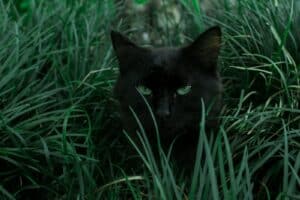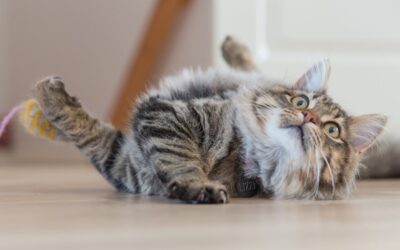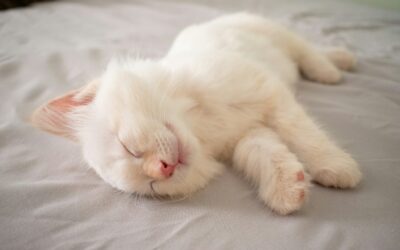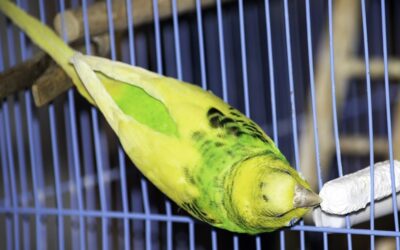Ever wondered what life looks like through the eyes of your feline friend? What colors can cats see? While humans are able to see a vibrant spectrum of colors, cats experience the world in a way that is uniquely their own.
Understanding the nuances of a cat’s vision can provide insights into their behavior and preferences, from choosing the right toys to designing their living spaces. In this blog post, we’ll explore the fascinating world of feline vision, including the colors cats can see, their night vision capabilities, and how their visual experience compares to ours.

The Basics of Feline Vision
Cats have a different set of visual skills compared to humans. While our vision is more attuned to perceiving a wide range of vibrant colors, cats have evolved to be excellent at detecting movement and seeing in low-light conditions.
This is primarily due to the high density of rod cells in the retina, which are responsible for light sensitivity and motion detection. These rod cells allow cats to see well in dim light, making them effective hunters, especially at dawn and dusk when their prey is most active.
In contrast, humans have more cone cells, which are responsible for color vision. This difference means that while we can appreciate the full spectrum of colors, cats have a more limited color vision.
However, their superior ability to detect slight movements makes them adept predators, capable of tracking fast-moving objects with ease.

Exploring Color Perception in Cats
Cats can perceive some colors, but their palette is not as varied as ours. They are often thought to be colorblind in the same way as humans with red-green color blindness.
This means they have difficulty distinguishing between red and green hues, which often appear as shades of gray or brown to them. However, they can see shades of blue and green quite well.
While cats may not appreciate the full array of colors like humans do, they are sensitive to yellow green wavelengths of light. This means they might be able to enjoy the vibrant tones of certain cat toys that fall within these colors.
Understanding the colors cats can see can help you tailor their environment to better suit their visual preferences.

How Cats See in Dim and Bright Light
One of the most remarkable features of a cat’s vision is its ability to see in low-light conditions. Thanks to the abundance of rod cells in their eyes, cats can magnify light that enters their eyes, allowing them to see clearly in dim lighting.
This ability is further enhanced by a reflective layer behind the retina known as the tapetum lucidum, which reflects light back through the retina, effectively doubling the amount of light available to the photoreceptors.
In bright light, however, a cat’s vision is not as sharp. Their eyes are designed to function optimally in low light, which means they do not perceive bright colors with the same clarity as humans. This is why cats often squint or seek shade in bright daylight.
Despite this limitation, their ability to perceive slight movements and rapid changes in their environment remains impressive.

Comparison Between Human and Feline Vision
When comparing human and feline vision, it’s essential to recognize the different evolutionary paths each species has taken. Humans have developed a visual system that emphasizes color differentiation and detail, which aids in tasks such as recognizing faces and reading text.
In contrast, cats rely on their vision to detect prey and avoid predators, leading to adaptations that enhance their ability to see in the dark and detect movement.
While humans can appreciate a broader range of colors, cats have a wider field of view and excellent peripheral vision, which allows them to track objects in their environment without moving their heads.
Additionally, cats are nearsighted, meaning they see clearer objects that are close to them better than those at a distance, unlike humans who typically have a longer focal length.
The Role of Rod and Cone Cells
Understanding the role of rod and cone cells is key to appreciating the differences in human and feline eyes. Rod cells are responsible for light sensitivity and motion detection, while cone cells enable color vision.
Cats have many more rod cells than humans, which is why they excel in detecting movement and seeing in low light. However, they have fewer cone cells, resulting in limited color perception.
The distribution of these cells also affects visual acuity or the sharpness of vision. Human vision has a higher density of cone cells in the center of the retina, providing detailed and precise vision.
Cats, on the other hand, have a more even distribution of rod cells, allowing them to detect movement across a wider area but with less focus on detail.

The Impact of Visual Acuity on Behavior
The visual acuity of cats directly influences their behavior and interaction with their environment. Their ability to detect even the slightest movements makes them skilled hunters, able to pounce on prey with precision.
This keen sense of movement extends to how they play with toys and interact with their surroundings. Toys that mimic the erratic movement of prey are particularly engaging for cats, as they tap into their natural instincts.
Cats also rely heavily on their sense of sight to communicate with their owners and other animals. Their body language, including the position of their eyes and ears, conveys important social cues.
Understanding how cats see the world can help pet owners interpret these signals and respond appropriately to their feline companions’ needs.

The Significance of Peripheral Vision
Cats have a wider field of view compared to humans, thanks to their excellent peripheral vision. This allows them to keep an eye on their surroundings and detect potential threats or opportunities with ease.
Their peripheral vision is particularly advantageous when hunting, as it enables them to track the movement of prey even when it is not directly in their line of sight.
Peripheral vision also contributes to a cat’s ability to move gracefully and avoid obstacles, making them agile and efficient climbers. This is why cats can often be seen navigating narrow ledges or jumping from one surface to another with precision.
Their sharp peripheral vision ensures they can assess their environment quickly and make split-second decisions.
The Evolutionary Advantage of Night Vision
The evolutionary advantage of night vision in cats is rooted in their ancestry as nocturnal hunters. Being able to see in the dark provided a significant advantage for catching prey during the twilight hours when many other animals were less active.
This ability is still present in domestic cats, allowing them to remain alert and active during the evening and early morning hours.
Cats’ night vision capabilities are a result of their rod-rich retinas and the presence of the tapetum lucidum. This combination enhances their ability to detect movements and see in low light, making them formidable hunters even in near darkness.
Understanding this aspect of feline vision can help pet owners cater to their cats‘ natural behaviors and ensure they have an environment that satisfies their instincts.

How Cats Interact with Different Colors
While cats may not perceive colors with the same richness as humans, they can still distinguish between certain hues. Blue-violet are the most discernible colors for cats, while red and orange appear more muted.
This means that toys and accessories in shades of blue and green might be more visually appealing to cats, encouraging play and exploration.
When decorating a space for your cat or selecting a new cat toy, considering their color vision can enhance their experience. Opt for items in colors that stand out to them, ensuring they are engaging and stimulating.
This understanding can lead to more meaningful interactions between you and your cat, as you tailor their environment to suit their visual preferences.
The Influence of Light Levels on Cat Vision
Light levels play a crucial role in how cats perceive their environment. Due to their evolutionary adaptations, cats see best in dim lighting conditions.
This is why they are often more active at night or during the early morning hours, when their vision is most effective. In bright light, however, cats may become less active and seek shaded areas to avoid discomfort.
Understanding the influence of light levels on cat vision can help pet owners create an environment that supports their feline friends’ natural behaviors. Providing a mix of shaded and well-lit areas allows cats to choose where they feel most comfortable.
This consideration not only improves their quality of life but also enhances their ability to engage with their surroundings.

Relevant Resources For Understanding Your Feline Friend For A Better Companionship
- Understanding Cat Behavior and Body Language – A guide to interpreting the signals your cat gives through body language.
- Creating a Cat-Friendly Home – Tips for setting up your living space to cater to your feline’s needs.
- The Science of Cat Vision – An exploration of the unique visual capabilities of cats and how they perceive the world.
- Choosing the Right Toys for Your Cat – A list of engaging toys that align with your cat’s natural hunting instincts.
- How to Keep Your Indoor Cat Happy – Strategies to ensure your indoor cat remains stimulated and content.
- Understanding Feline Nutrition and Diet – Essential information about feeding your cat a balanced and nutritious diet to support their health and well-being.

Conclusion | What Colors Can Cats See?
Visit Kate’s K9 Pet Care’s website and explore all of the services we can offer your dog, cat, and other small pets!
Exploring the world through a cat’s eyes reveals a unique perspective that is both fascinating and insightful. By understanding how cats perceive colors, light, and movement, we can better cater to their needs and enhance their quality of life.
From selecting the right toys and accessories to creating a supportive environment, appreciating the nuances of feline vision allows us to connect with our pets on a deeper level. Whether you’re a cat lover, pet owner, or animal enthusiast, there’s always more to learn about the captivating ways our feline friends experience the world.







